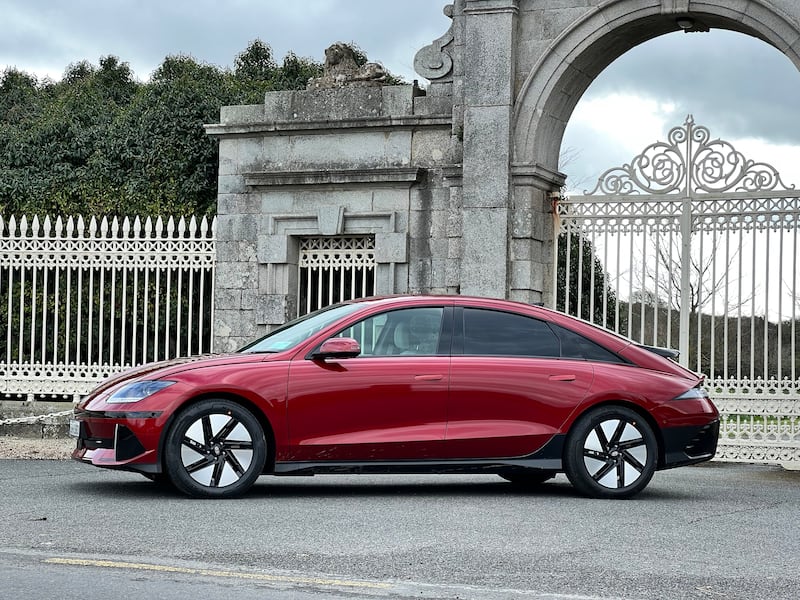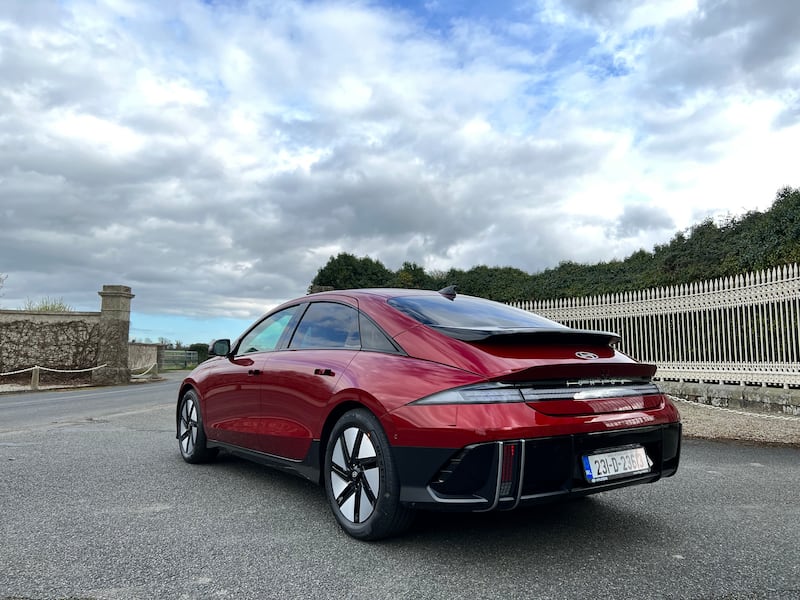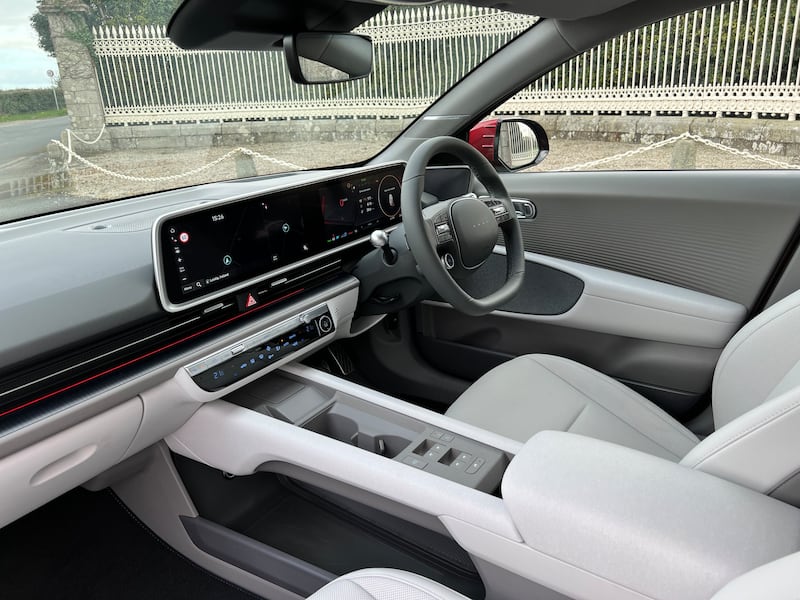It may look like a cut-and-shut comprising the front of a coupe and the rear end of a Porsche, but the Ioniq 6 is firmly in the saloon camp. Which is great news for those seeking an alternative to SUVs.
Hats off to Hyundai for once again proving that not everything on four wheels needs to be a mock-rugged box. Not that the Koreans don’t offer plenty of these, but in both the Ioniq 5 and now this new EV they have attempted to move the dial.
Where the 5 tends to be a big hatch alternative to the crossover crowd, the new 6 is perhaps in slightly more traditional turf, a coupe saloon format. Yet it’s strikingly different from other coupe saloons out there right now.
Hyundai marked our card with a stunning concept several years ago that looked like a rejigged Audi TT. The end result may not be as sleek, but then it’s a lot more practical.
‘There are times I regret having kids. They’re adults, and it’s now that I’m regretting it, which seems strange’
Cillian Murphy: ‘You had the Kerry babies, the moving statues, no abortion, no divorce. It was like the dark ages’
The Dublin couple who built their house in a week
John Creedon: ‘I was always being sent away, not because they didn’t love me, but because they couldn’t cope’
On looks alone Hyundai should be on to a winner with this car, even if it tends to divide the crowd. Some love it, some hate it but everyone seems to have a view. And that’s what you want in a car. Many of the most memorable models were divisive at launch.


The slippery styling isn’t just for show: this car rivals the best of the sleek EVs when it comes to aerodynamics. To put it in perspective, the Ioniq 6 scores better for aerodynamics (coefficient of drag) than the Audi e-tron GT or Porsche Taycan. And that’s with properly spacious back seats and headroom.
Aerodynamics are important to eke out every last electron of range from the battery and the end result is a claimed 614km from the 77kW battery pack with rear-wheel-drive or 429km from the 53km battery pack in the same format.
Our time spent in the 77kW saw it easily deliver more than 400km, driving mostly at motorway speeds. A mix of more suburban runs should get you close to the claimed range. That should keep you from frequenting charging stations too often. Not that you will be there for long: hooked to an ultra-fast charger such as Ionity, the Ioniq 6 can recharge from 10 per cent to 80 per cent in just 18 minutes.
Like the Ioniq 5 (both share the same platform), this car operates as a part-time mobile power bank, with buyers having the option of powering your household appliances from the car’s battery. Using a V2L cable, one end goes into the car’s charge port and the other has a regular three-pin socket so you can keep any important household tech running even during a blackout.
Speaking of tech, there’s a lot to get your head around in this Ioniq 6. The cabin is clean and uncluttered, giving the impression of simplicity, but delve into the functions on the touchscreen and you start to appreciate the complexity. There’s an array of toys to show off to the neighbours, not least the latest self-parking system that lets you exit the car and watch as the Ioniq 6 twists and turns into its allotted space. You can then take the car out again using buttons on the key fob before getting in and driving away, leaving onlookers notably impressed or annoyed.
[ The Irish Times car buyer’s guide for 2023: The best electric carsOpens in new window ]
When it is your time behind the wheel, the Hyundai proves itself at the top of its game. It might not match the BMW i4 for agility or the Tesla Model 3 for pace, but it delivers the comfort and refinement of a premium player.
Steering feel can be adjusted – as can throttle response – through the car’s set-up and drive modes, but it’s arguably not quite as sharp as its coupe looks might suggest. However, approach this EV as a sleek comfortable cruiser and you’ll be pleasantly surprised.
A time of 7.1 seconds from 0-100km/h isn’t as quick as some rivals, but the Ioniq 6 is incredibly smooth and quiet. There’s a serenity in the cabin as you munch away at the miles, on a par with more premium brand rivals.

Trim choices start with a well-equipped Signature model, stepping up to the Elegance of our test car which comes with leather seats, a higher level of driver assistance, a Bose stereo and heated rear seats. There’s also a range-topping Finesse model which comes with the 20-inch wheels, more power and the four-wheel drive system.
The cabin itself is smart, but there are touches where it could be better. For example, the plastics used are not as good as we had hoped in places, such as the central console, while the seating position is unusually high for a saloon car, due to the fact you are sitting on the big battery pack. We kept trying to lower the seat, but it simply wouldn’t go any closer to the ground. It’s a minor point, though, for this Hyundai is amply comfortable to wile away the miles.
In the back, there’s truly impressive legroom and headroom, though the price for the sleek styling does seem to be come in the bootspace, which is an ample 401 litres, though the decision to make it a saloon rather than a fastback means the aperture can prove a little tight for loading boxes and the like. If you are a regular at Ikea then the Ioniq 5 might be a better fit for you.
And that’s the thing with this car: for many Irish buyers who have abandoned saloons for SUVs, the transition back might not be clear-cut if they’ve got used to that extra practicality. The Ioniq 6 is more expensive than its crossover sibling, although it does deliver better range thanks to its sleeker profile and has a high level of standard features. For the 53kwh battery version, prices start at €48,295 (or €49,795 if ordered after July 1st when the SEAI grant is reduced). That’s €7,300 more than the Ioniq 5 with the same battery pack. The long-range 77kWh ioniq 6 starts from €54,315, which is €5,000 more than the 77kWh Ioniq 5.
Hyundai reckons a 50:50 split in its full-year sales between these two EVs, which suggests that sleek style and better range will win over a substantial portion of its forecourt clientele. Time will tell.
As to its external rivals, names that come to mind are the Tesla Model 3 or the Polestar 2, mainly as they are also alternatives to the EV crossover cavalcade. Keeping company with these brands is credit to just how far Hyundai has come in recent years. The fact that you could see strong merit in opting for Ioniq 6 over a Model 3 should please plenty of Koreans.
The Ioniq 5 was our Irish Times Car of the Year when it arrived back in 2022 and it was going to be a tough act to follow. Hyundai has pulled it off with aplomb.
Hyundai Ioniq 6 77kW Elegance: the lowdown
Power: A 77kW battery pack powering a 229ps electric motor delivering rear-wheel drive performance
0-100km/h: 7.4 secs
WLTP range: 614km
Price: €62,495 if ordered before July 1st (range starts with 53kW Signature version at €48,295)
Our verdict: Slipstream sleek coupe saloon with the EV range to win over new buyers to the Korean brand




